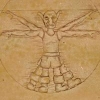Quick Blender Wavefront export question...
I downloaded a Blender 3D model and exported it to the wavefront (.obj) format.
Looking through the data it output, it's fairly obvious that the g statements, eg.
g Cube.018_Cube.016_Material.002
refer to groups, sets of data that together compose a sub-object.
However, they also have some o statements. Here are 3 different ones:
o Cube.018_Cube.016
o Cylinder.015_Cylinder.013
o Cube.015_Cube.013
If you look up the o statement in the Wavefront spec at
http://www.martinreddy.net/gfx/3d/OBJ.spec
...you'll see that the o statement is described as follows:
o object_name
Polygonal and free-form geometry statement.
Optional statement; it is not processed by any Wavefront programs.
It specifies a user-defined object name for the elements defined
after this statement.
object_name is the user-defined object name. There is no default.
...so as far as official WaveFront programs are concerned, the o statement is an optional extra-information statement. However, above, different values exist in the data generated by Blender.
For wavefront exporting, does Blender use the o statement to create groups of groups, or is this just functioning sort of like a comment, giving more information about the data?
The 'o' statement is not unique. If you got 10 objects in your scene you will encounter 10 o-statements, each at the beginning of the according data block.
-
Ashaman
-
Ashaman
So Blender uses o to represent having multiple objects in a scene? Thus you could have multiple objects in a scene (o elements), each composed of multiple groups (g elements, essentially subobjects)?
The meaning of groups and objects is quite flexible. I.e. the export is able to group objects by material or by object-groups. Take a look at the .obj exporter description.
--
Ashaman
--
Ashaman
This topic is closed to new replies.
Advertisement
Popular Topics
Advertisement
Recommended Tutorials
Advertisement







